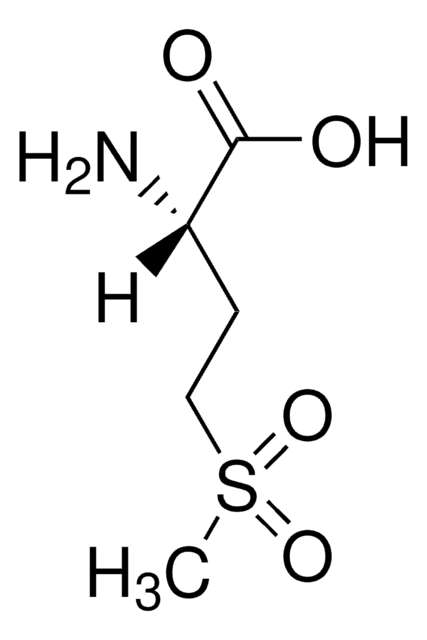S3132
Seleno-L-methionine
≥98% (TLC), powder
Synonim(y):
(S)-2-Amino-4-(methylseleno)butyric acid
About This Item
Polecane produkty
Poziom jakości
Próba
≥98% (TLC)
Postać
powder
kolor
white to off-white
rozpuszczalność
H2O: 50 mg/mL
temp. przechowywania
−20°C
ciąg SMILES
C[Se]CC[C@H](N)C(O)=O
InChI
1S/C5H11NO2Se/c1-9-3-2-4(6)5(7)8/h4H,2-3,6H2,1H3,(H,7,8)/t4-/m0/s1
Klucz InChI
RJFAYQIBOAGBLC-BYPYZUCNSA-N
Szukasz podobnych produktów? Odwiedź Przewodnik dotyczący porównywania produktów
Opis ogólny
Zastosowanie
- in toxicity studies in Japanese Medaka embryos
- to study its effects on selenium status indicators in pregnant long-tailed macaques (Macaca Fascicularis)
- to label proteins for single wavelength anomalous dispersion (SAD) phasing
- as a nonchemical stressor to treat Japanese Medaka fish embryos
- to label proteins for Single wavelength Anomalous Dispersion (SAD) phasing
- to study the distribution and inhibition effects of seleno-L-methionine on 4T1 mouse mammary carcinoma
Działania biochem./fizjol.
Hasło ostrzegawcze
Danger
Zwroty wskazujące rodzaj zagrożenia
Zwroty wskazujące środki ostrożności
Klasyfikacja zagrożeń
Acute Tox. 3 Inhalation - Acute Tox. 3 Oral - Aquatic Acute 1 - Aquatic Chronic 1 - STOT RE 2
Kod klasy składowania
6.1A - Combustible, acute toxic Cat. 1 and 2 / very toxic hazardous materials
Klasa zagrożenia wodnego (WGK)
WGK 3
Temperatura zapłonu (°F)
250.3 - 346.3 °F
Temperatura zapłonu (°C)
121.3 - 174,6 °C
Certyfikaty analizy (CoA)
Poszukaj Certyfikaty analizy (CoA), wpisując numer partii/serii produktów. Numery serii i partii można znaleźć na etykiecie produktu po słowach „seria” lub „partia”.
Masz już ten produkt?
Dokumenty związane z niedawno zakupionymi produktami zostały zamieszczone w Bibliotece dokumentów.
Produkty
Antioxidants protect biological systems from oxidative damage produced by oxygen-containing free radicals and from redoxactive transition metal ions such as iron, copper, and cadmium.
Nasz zespół naukowców ma doświadczenie we wszystkich obszarach badań, w tym w naukach przyrodniczych, materiałoznawstwie, syntezie chemicznej, chromatografii, analityce i wielu innych dziedzinach.
Skontaktuj się z zespołem ds. pomocy technicznej








